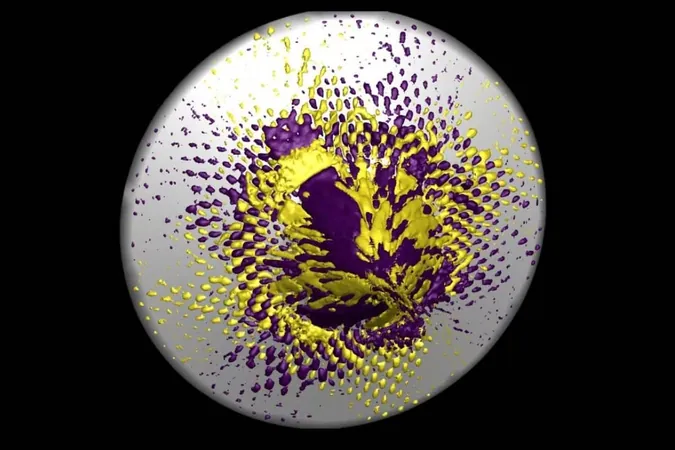
Groundbreaking Discovery in Hypersonic Research: Supercomputer Reveals Chaos at Mach 16!
2025-03-29
Author: Siti
The Unseen Turbulence of Hypersonic Flight
Hypersonic flight, defined as velocities exceeding Mach 5, presents a daunting array of engineering challenges due to the intricate interactions between air molecules and vehicle surfaces. These extreme speeds generate intense shock waves, volatile boundary layers, and phenomena previously thought to be well understood. Until now, conventional simulations and wind tunnel experiments struggled to accurately depict these dynamic interactions in three dimensions.
In a groundbreaking approach, a team led by Professor Deborah Levin and doctoral student Irmak Taylan Karpuzcu utilized advanced software and Frontera, one of the world's most powerful academic supercomputers, to simulate airflow around cone-shaped geometries at Mach 16. Their findings were astonishing: rather than the expected smooth flow patterns, they observed chaotic turbulence characterized by angular instabilities, wavy separation lines, and significant disruptions in flow.
Breaking Assumptions: The Erratic Nature of Flow
The simulations revealed a stark contrast to predictions of uniform, concentric "ribbons" of airflow; instead, they identified chaotic structures such as shock layer discontinuities and abrupt density shifts, particularly near the tips of the cones. At Mach 16, shock waves are compressed tightly against the vehicle's surface, creating unstable and viscous layers of air. This discovery casts doubt on the long-held belief that axial symmetry—considered a hallmark of hypersonic designs—remains intact at such extreme velocities.
Test runs conducted at Mach 6 did not exhibit these irregularities, demonstrating the emergence of instability that is uniquely dependent on speed. This insight raises significant concerns regarding the viability of extrapolating lower-speed test findings to the complexities of full-scale hypersonic systems.
Monte Carlo Method: A Breakthrough in Simulation Techniques
One of the pivotal advancements in this research was the application of the Direct Simulation Monte Carlo (DSMC) method—an innovative statistical technique that tracks the interactions of individual air molecules during billions of randomized collisions. Unlike traditional deterministic modeling, DSMC incorporates probabilistic elements into collision dynamics, allowing for a more nuanced understanding of hypersonic flow.
The analysis revealed that the airflow around a double-cone configuration splits into two distinct turbulent zones, demonstrating a 180-degree symmetry pattern. To corroborate these findings, researchers applied linear stability analysis using triple-deck theory, which reinforced the scientific validity of their results.
Significant Design Implications for Aerospace Engineering
The double-cone model, representative of many hypersonic vehicle designs and re-entry bodies, illuminated a crucial design flaw: what was once deemed a stable aerodynamic structure may actually give rise to unexpected thermal and mechanical stresses.
Karpuzcu commented on the importance of their discoveries, stating, "This level of insight into three-dimensional effects and unsteady flow was previously unattainable. Past 3D experiments lacked the sensor density to capture the complexities around the conical shapes."
A Paradigm Shift for Fluid Dynamics in Aerospace
This study marks a watershed moment for our understanding of fluid dynamics in the hypersonic realm. By demonstrating that flow symmetry does not persist at Mach 16, the research team has instigated a paradigm shift that necessitates a reevaluation of testing methodologies, design frameworks, and safety measures in aerospace design. With the stakes so high in hypersonic travel—ranging from national defense applications to commercial spaceflight—the implications of this research could redefine the future of flight.
Stay tuned as we delve deeper into the evolving world of hypersonic technology and discover what these groundbreaking insights mean for our next generation of aerospace innovations!



 Brasil (PT)
Brasil (PT)
 Canada (EN)
Canada (EN)
 Chile (ES)
Chile (ES)
 Česko (CS)
Česko (CS)
 대한민국 (KO)
대한민국 (KO)
 España (ES)
España (ES)
 France (FR)
France (FR)
 Hong Kong (EN)
Hong Kong (EN)
 Italia (IT)
Italia (IT)
 日本 (JA)
日本 (JA)
 Magyarország (HU)
Magyarország (HU)
 Norge (NO)
Norge (NO)
 Polska (PL)
Polska (PL)
 Schweiz (DE)
Schweiz (DE)
 Singapore (EN)
Singapore (EN)
 Sverige (SV)
Sverige (SV)
 Suomi (FI)
Suomi (FI)
 Türkiye (TR)
Türkiye (TR)
 الإمارات العربية المتحدة (AR)
الإمارات العربية المتحدة (AR)